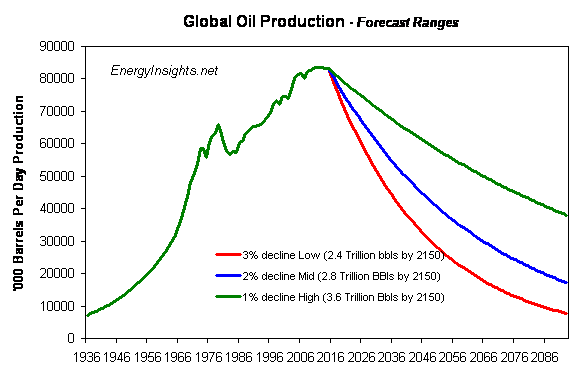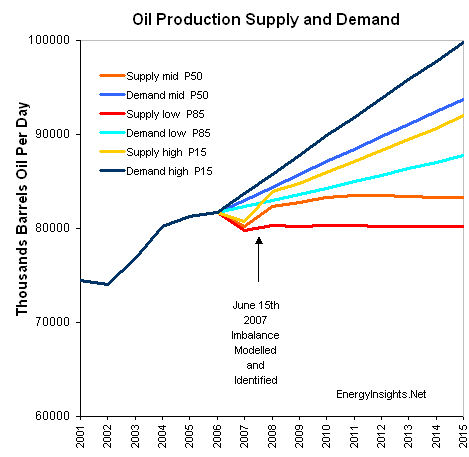|
|
|
|
|
EnergyInsights.net team
In early August when oil prices were $70 / bbl, we predicted to our website users that oil prices would be $125 / bbl by the end of 2008.
 Oil prices today reached $92 / bbl. Oil prices have risen from $20 / bbl in 2001 to $92 / bbl today – which seems like a steep rise. But sorry, “you aint seen nothing yet” – we predict this is just the start of a massive oil price hike. Note we say hike rather than spike. We do not believe they will shoot up then come crashing back down again. We predict they will rise continuously on a see-saw upward trend. October is normally a period of low global oil demand – but when the northern hemisphere winter hits, do not be surprised to see $100 / bbl.
Oil prices today reached $92 / bbl. Oil prices have risen from $20 / bbl in 2001 to $92 / bbl today – which seems like a steep rise. But sorry, “you aint seen nothing yet” – we predict this is just the start of a massive oil price hike. Note we say hike rather than spike. We do not believe they will shoot up then come crashing back down again. We predict they will rise continuously on a see-saw upward trend. October is normally a period of low global oil demand – but when the northern hemisphere winter hits, do not be surprised to see $100 / bbl.
So why are oil prices rising? Simple – supply and demand. Demand is booming with the growth of

OPEC says there is plenty of oil in the system, but meanwhile US inventories took a sharp drop on 25th October 2007 – the early signs of a supply crunch. By October 2008, people wont be talking about a credit crunch or climate change, they’ll be talking about "Peak Oil" and an oil supply crunch.
Our unique analysis indicates that supply will plateau at current levels for the next 5 years – meanwhile demand is rising by 1.3 million barrels per day each year.
We believe there are a number of reasons why oil supply will not increase much further, if at all:
· OPEC countries can barely produce any more – they expanded investment about two years ago and new capacity will only replace existing declines
· Even if OPEC could produce more, there is no point creating an artificial supply spike only for levels to dramatically drop off – they probably believe it’s better to let demand rise and feed in reduced supplies – sending prices higher but also preserving stock for future years and generations.
· Because oil is sold in US dollars and the US dollar has depreciated about 30% in the last year, much of the increase in the oil prices is driven by
· National oil companies and OPEC countries are reluctant to let in foreign investment from western or international oil companies – they see few benefits from such collaboration.
· Banks are reluctant to lend money for large energy projects because lead times are so long with deep cash sinks, costs are escalating, project completion times are slipping, and skills and material shortages make delivering projects on time and budget very difficult.
· Many countries such as
· Very few new large discoveries have been made in the last ten years – hence few opportunities exist to bring on stream new lower cost oil production.
· Demand in oil exporting nations has doubled in the last ten years as populations have increase by 50% and living standards have increased – these exporting nations also need oil to fuel their own economies – there’s simply not enough to go around!

The future for energy security and supply looks increasing bleak. We have likely already reached Peak Oil (or are very shortly to reach this point). Half the oil found has now been produced and it took 130 years to be produced. But the other half of remaining conventional oil reserves will only take 30 years to produce at existing production rates. A huge gap will soon open between supply and demand – and the only way to  close this is for oil prices to sky-rocket and people to switch to other fuel sources. The only problem is – there is no meaningful alternative for vehicles which use 70% of oil supplies. Be prepared to pay double the price petrol-gasoline in the next few years.
close this is for oil prices to sky-rocket and people to switch to other fuel sources. The only problem is – there is no meaningful alternative for vehicles which use 70% of oil supplies. Be prepared to pay double the price petrol-gasoline in the next few years.
The only good news is that so far, the increase in oil prices has not fed through to inflation to any great extent. This has surprised economists. No doubt it has also surprised OPEC countries. It has likely encouraged them to believe that demand will be high even if prices go up – and that if prices rise to say $100/bbl it would not lead to a global recession. So far so good as far as OPEC is concerned.
In 2001, if you’d have asked an economist what effect $100/bbl oil prices would have on the economy, they would probably have said – recession. But now, with global growth at 5% - most people would say – slight slowdown – may be by 0.5% GDP growth. So in a way, oil prices may have to rise to well over $150/bbl before demand destruction takes place. This is why we have been advising all our website visitors to expose themselves in property in oil boom towns and countries. There will be a massive re-distribution of wealth from oil importing nations to oil exporting nations. This is why were strongly advise you read our Special Reports:
We don’t expect you to email us back commending us for these insights. But we do expect you to recognize good business sense when you see it.
But all those people that want to write-off US investments, we have the following insights. We believe all the talk of the
The real losers will be the countries that have no coal, gas, oil, nuclear and forestry but still have energy intensive industries (e.g. no highly developed services industries). Examples of such countries are
And if you believe you’ll be okay at the filling station, the last place oil will end up is with the private citizen – they are at the end of the "food chain". Top priority will be given to:
· Government
· Public sector – hospitals, schools, refuge, fire brigade, police, military
· Manufacturing – drugs, plastics
· Agriculture – tractors, lorries for food distribution, pesticides, fertilizer
· Power – electricity, ice, heat, water salinity plants
The first shortages will be with private cars.
So to profit from the coming oil boom, invest in property in oil exporting nations –
If you want to avoid property all together, then the best business to be exposed to are:
Other businesses and trading that will do well in the oil price boom are:
The alternative energy we like the most is solar - costs are dropping rapildy and it is likely within the next 5-10 years this energy source will be competitive with coal burning and nuclear power plants. Electric cars will need charging - solar electric would be a truly clean and renewable future energy supply for vehicles and transport movements. Your higher risk investment funds could be put into solar as a hedge against the oil price boom and property price reductions.
We aim to increase your returns, and we hope these insights into the ensuing oil supply crunch will benefit your investment strategy and allow you to hedge against the biggest oil price hike you have ever seen - it's just beginning - and it will affect everyone.
If you have any comments, please contact us on enquiries@energyinsights.net